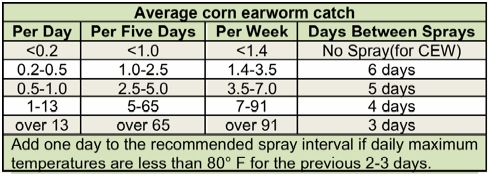Twelve of the 32 monitoring sites reported this week. European corn borer (ECB-E), ECB-Hybrid, and corn earworm (CEW) were each caught at one site. No other moths were caught this week.
The first spring flight of ECB-E typically begins when accumulated growing degree days (GDD), using a modified base of 50°F, reach 374. Current GDD accumulation averages around 408 across reporting sites, indicating that the first spring moths of ECB-E are now flying.
Although corn earworm typically lays eggs on silks and primarily damages the ear, it can also feed on whorl-stage corn when silks are not yet available. Their feeding damage more closely resembles that of fall armyworm (see photo below).

Injury to corn leaves caused by corn earworm larvae. (photo: Dan Schaeffer, Illini FS, Tolono, Illinois).
If the map is not visible and you are using Firefox as your browser, be sure to turn off enhanced tracking by going to the blue shield icon to the left of the URL address bar.



